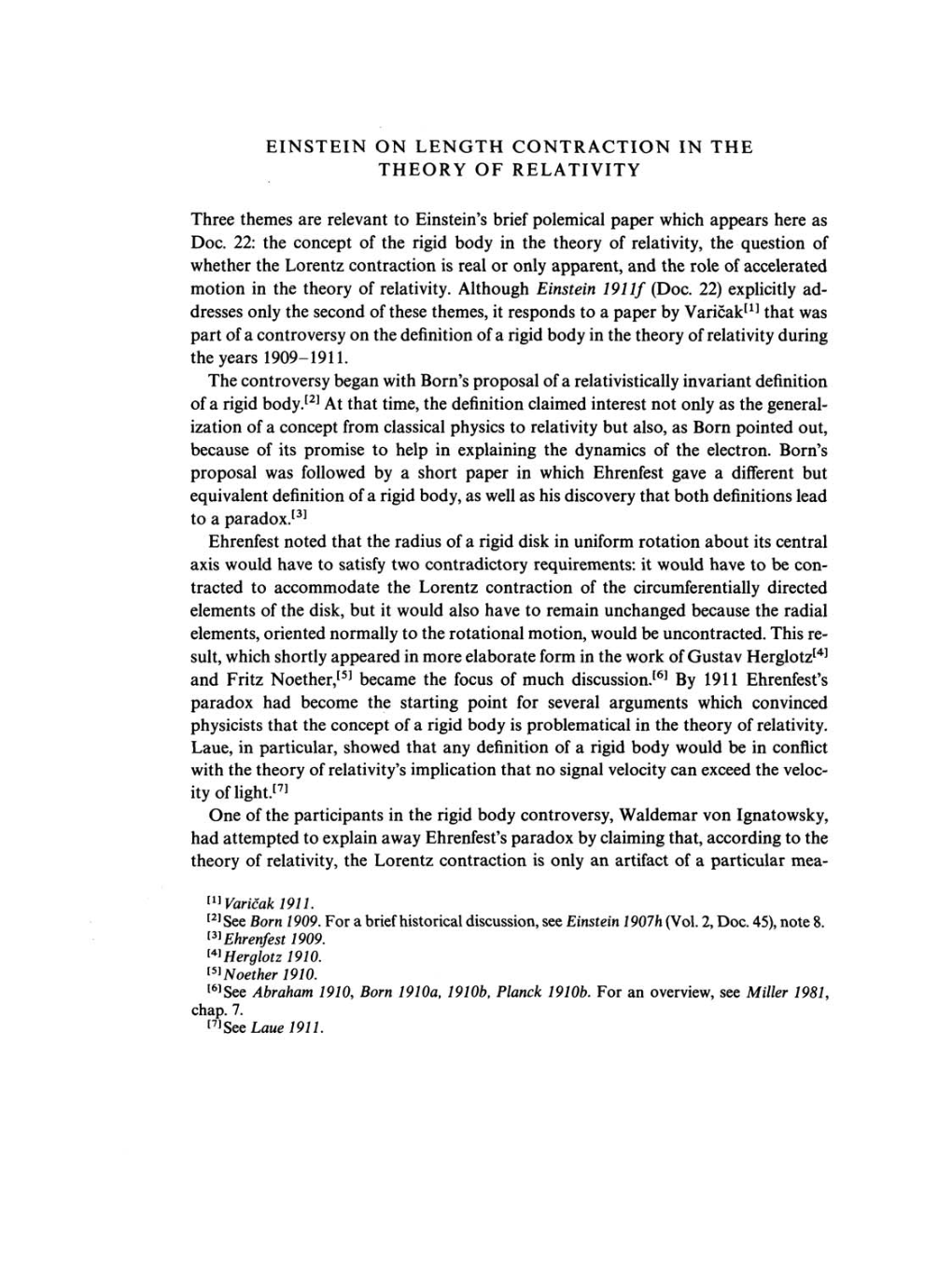EINSTEIN ON
LENGTH
CONTRACTION IN THE
THEORY OF RELATIVITY
Three themes
are
relevant
to
Einstein's brief
polemical
paper
which
appears
here
as
Doc. 22:
the
concept
of
the
rigid body
in the
theory
of
relativity,
the
question
of
whether the Lorentz contraction
is
real
or
only apparent,
and the role of accelerated
motion
in
the
theory
of
relativity. Although
Einstein 1911f
(Doc.
22)
explicitly
ad-
dresses
only
the second of these
themes, it
responds
to
a
paper
by
Varicak[1]
that
was
part
of
a
controversy
on
the definition of
a
rigid body
in
the
theory
of
relativity during
the
years
1909-1911.
The
controversy began
with Born's
proposal
of
a
relativistically
invariant definition
of
a
rigid
body.[2]
At
that
time,
the definition claimed interest
not
only
as
the
general-
ization of
a
concept
from classical
physics
to
relativity
but
also,
as
Born
pointed out,
because of its
promise
to
help
in
explaining
the
dynamics
of
the electron. Born's
proposal
was
followed
by a
short
paper
in
which Ehrenfest
gave
a
different but
equivalent
definition of
a
rigid body, as
well
as
his
discovery
that
both definitions lead
to
a paradox.[3]
Ehrenfest noted
that
the radius of
a rigid
disk
in
uniform rotation
about
its
central
axis
would have
to
satisfy
two
contradictory requirements:
it would have
to
be
con-
tracted
to
accommodate the Lorentz contraction of the
circumferentially
directed
elements of the
disk,
but
it
would also have
to
remain
unchanged
because the radial
elements,
oriented
normally
to
the rotational
motion,
would
be
uncontracted. This
re-
sult,
which
shortly appeared
in
more
elaborate form
in
the work of Gustav
Herglotz[4]
and Fritz
Noether,[5]
became the
focus
of much
discussion.[6]
By
1911
Ehrenfest's
paradox
had become the
starting point
for several
arguments
which convinced
physicists
that the
concept
of
a
rigid body
is
problematical
in
the
theory
of
relativity.
Laue,
in
particular,
showed
that
any
definition of
a
rigid body
would be in conflict
with the
theory
of
relativity's implication
that
no
signal velocity
can
exceed the
veloc-
ity
of
light.[7]
One of the
participants
in the
rigid body controversy,
Waldemar
von
Ignatowsky,
had
attempted
to
explain away
Ehrenfest's
paradox by claiming
that,
according
to
the
theory
of
relativity,
the Lorentz contraction is
only
an
artifact of
a
particular
mea-
[1]Varicak
1911.
[2]See Born 1909.
For
a
brief historical
discussion,
see
Einstein
1907h
(Vol. 2,
Doc.
45),
note
8.
[3]Ehrenfest
1909.
[4]Herglotz
1910.
[5]Noether
1910.
[6]See
Abraham
1910,
Born
1910a, 1910b,
Planck
1910b.
For
an
overview,
see
Miller
1981,
chap. 7.
[7]See
Laue
1911.
